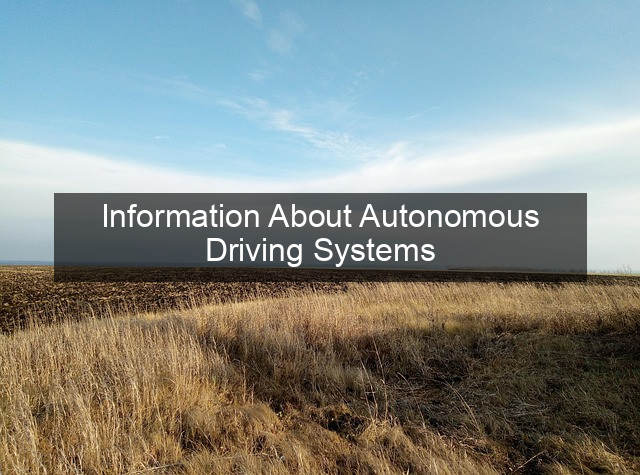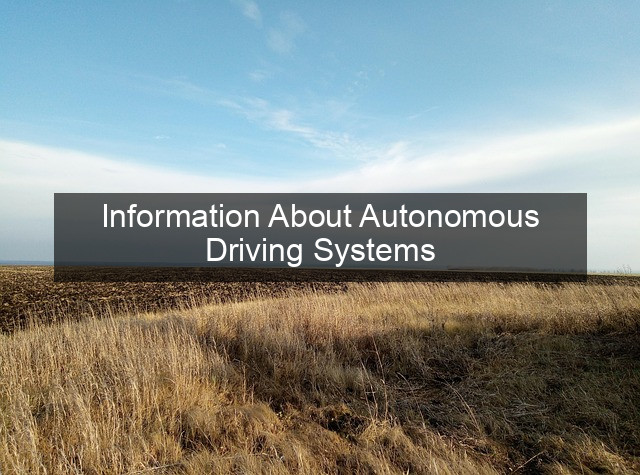Information About Autonomous Driving Systems

- Information About Autonomous Driving Systems
- The Rise of Autonomous Driving Systems: A Revolution on Wheels
- How Autonomous Vehicles Perceive the World
- Sensor Technology: The Eyes and Ears of Self-Driving Cars
- Data Fusion: Making Sense of the Sensory Input
- Mapping and Localization: Knowing Where You Are
- The Brains Behind the Wheel: Autonomous Driving Software
- Artificial Intelligence and Machine Learning
- Path Planning and Decision Making
- Control Systems: Translating Decisions into Actions
- The Impact of Autonomous Driving on Society
- Safety and Accident Reduction
- Increased Efficiency and Productivity
- Enhanced Mobility for All
- The Road Ahead: Challenges and Opportunities
- Regulatory Frameworks and Legal Considerations
- Ethical Dilemmas and Societal Implications
- Conclusion
- Frequently Asked Questions

The Rise of Autonomous Driving Systems: A Revolution on Wheels
Imagine a world where traffic jams are relics of the past, and car accidents are a rare anomaly. This is the promise of autonomous driving systems, a rapidly evolving technology poised to reshape transportation as we know it. Autonomous driving, also known as self-driving, refers to the ability of a vehicle to navigate and operate without human intervention. This transformative technology relies on a complex interplay of sensors, software, and artificial intelligence to perceive the environment and make driving decisions. From improved safety and increased efficiency to enhanced mobility for all, the potential benefits of autonomous driving are vast and far-reaching. But the journey to fully autonomous vehicles is complex, fraught with technical challenges and ethical considerations. This article delves into the intricacies of autonomous driving systems, exploring their underlying technologies, potential impact, and the road ahead.
How Autonomous Vehicles Perceive the World
Sensor Technology: The Eyes and Ears of Self-Driving Cars
Autonomous vehicles rely on a suite of sophisticated sensors to gather information about their surroundings. These sensors act as the eyes and ears of the car, providing a 360-degree view of the environment. Cameras capture visual data, while lidar uses laser beams to create a 3D map of the surrounding area. Radar detects objects and measures their speed and distance, even in adverse weather conditions. Ultrasonic sensors are used for short-range detection, particularly helpful for parking and maneuvering in tight spaces.
The data from these sensors is constantly being processed and analyzed to create a comprehensive understanding of the environment. This allows the vehicle to identify obstacles, interpret traffic signals, and navigate safely.
The ongoing development of sensor technology is crucial for the advancement of autonomous driving. More accurate and reliable sensors are essential for enhancing the safety and performance of self-driving cars.
Data Fusion: Making Sense of the Sensory Input
The sheer volume of data generated by these sensors requires a powerful data fusion system. Data fusion is the process of combining data from multiple sensors to create a more complete and accurate picture of the environment. This involves sophisticated algorithms that filter noise, resolve discrepancies, and integrate the information into a unified representation.
Effective data fusion is critical for robust autonomous driving. It allows the vehicle to make informed decisions based on a comprehensive understanding of its surroundings, even in complex and dynamic environments.
Advances in data fusion techniques are essential for improving the reliability and safety of autonomous vehicles.
Mapping and Localization: Knowing Where You Are
Precise mapping and localization are fundamental to autonomous driving. High-definition maps provide detailed information about the road network, including lane markings, traffic signals, and speed limits. The vehicle uses this information in conjunction with GPS and other localization technologies to determine its precise location within the map.
Accurate localization is essential for safe and efficient navigation. It allows the vehicle to plan its route, follow traffic laws, and avoid obstacles.
Ongoing improvements in mapping and localization technologies are crucial for the widespread adoption of autonomous vehicles.
The Brains Behind the Wheel: Autonomous Driving Software
Artificial Intelligence and Machine Learning
Artificial intelligence (AI) and machine learning (ML) are at the heart of autonomous driving systems. These technologies enable the vehicle to learn from data, adapt to changing conditions, and make intelligent driving decisions. Machine learning algorithms are trained on vast datasets of driving scenarios, allowing them to recognize patterns, predict behaviors, and improve their performance over time.
AI algorithms process the sensory data, interpret the environment, and make decisions about steering, acceleration, and braking. They also enable the vehicle to plan routes, navigate intersections, and respond to unexpected events.
The continued development of AI and ML is essential for achieving higher levels of autonomy and safety in self-driving cars.
Path Planning and Decision Making
Path planning algorithms determine the optimal route for the vehicle to take, considering factors such as traffic conditions, road geometry, and destination. These algorithms generate a series of waypoints that the vehicle follows to reach its destination safely and efficiently.
Decision-making algorithms are responsible for choosing the appropriate actions in response to various situations. These algorithms consider the information from the sensors, the planned path, and the current traffic conditions to make decisions about speed, lane changes, and other driving maneuvers.
Advances in path planning and decision-making algorithms are crucial for enhancing the performance and safety of autonomous vehicles.
Control Systems: Translating Decisions into Actions
Control systems translate the decisions made by the software into physical actions, such as steering, accelerating, and braking. These systems interact with the vehicle’s mechanical components to ensure precise and responsive control.
Advanced control systems are essential for ensuring the smooth and safe operation of autonomous vehicles. They must be able to respond quickly and accurately to changing conditions and maintain stability in various driving scenarios.
Ongoing development of control systems is crucial for improving the performance and reliability of self-driving cars.
The Impact of Autonomous Driving on Society
Safety and Accident Reduction
One of the most significant potential benefits of autonomous driving is improved safety. By eliminating human error, which is a major factor in most accidents, self-driving cars could drastically reduce the number of traffic fatalities and injuries.
Autonomous vehicles are programmed to follow traffic laws and maintain safe distances, reducing the risk of collisions. They are also not susceptible to distractions or fatigue, which can impair human drivers.
The widespread adoption of autonomous vehicles could lead to a significant improvement in road safety.
Increased Efficiency and Productivity
Autonomous driving could also lead to increased efficiency and productivity. Self-driving cars can optimize routes and reduce congestion, saving time and fuel. They can also allow passengers to utilize their travel time for work or leisure activities, increasing productivity.
Autonomous vehicles can also improve the efficiency of logistics and delivery services, reducing costs and delivery times.
The adoption of autonomous driving could have a significant positive impact on the economy and overall productivity.
Enhanced Mobility for All
Autonomous driving has the potential to enhance mobility for people who are unable to drive themselves, such as the elderly and people with disabilities. Self-driving cars can provide them with greater independence and access to transportation.
Autonomous vehicles can also improve access to transportation in underserved communities, providing greater mobility options.
The widespread availability of autonomous vehicles could significantly improve the quality of life for many people.
The Road Ahead: Challenges and Opportunities
Regulatory Frameworks and Legal Considerations
The development and deployment of autonomous vehicles require clear regulatory frameworks and legal considerations. Governments around the world are working to establish rules and regulations that address the safety, liability, and ethical implications of self-driving cars.
Establishing clear legal frameworks is essential for fostering innovation and ensuring the safe integration of autonomous vehicles into the transportation system.
The development of comprehensive regulations will be crucial for the successful deployment of autonomous driving technology.
Ethical Dilemmas and Societal Implications
Autonomous driving raises a number of ethical dilemmas and societal implications. For example, how should a self-driving car make decisions in unavoidable accident scenarios? Who is liable in case of an accident involving an autonomous vehicle?
Addressing these ethical and societal implications is crucial for building public trust and ensuring the responsible development of autonomous driving technology.
Open discussions and careful consideration of these issues are essential for the successful integration of autonomous vehicles into society.
Conclusion
The development of autonomous driving systems is a complex and multifaceted undertaking, with the potential to revolutionize transportation. While significant progress has been made, numerous challenges remain. From perfecting sensor technology and refining AI algorithms to navigating complex ethical dilemmas and establishing robust regulatory frameworks, the journey to fully autonomous vehicles is far from over. However, the potential benefits – increased safety, enhanced efficiency, and improved mobility for all – make this a pursuit worth pursuing. As technology continues to evolve and mature, autonomous driving is poised to reshape our cities, our economies, and our lives in profound ways. The road ahead may be challenging, but the destination promises a future of safer, more efficient, and more accessible transportation for everyone.

Frequently Asked Questions
What are the different levels of autonomous driving?
There are generally six levels of autonomous driving, ranging from Level 0 (no automation) to Level 5 (full automation). Higher levels indicate greater autonomy, with Level 5 vehicles requiring no human intervention under any circumstances.
How do autonomous vehicles handle adverse weather conditions?
Autonomous vehicles utilize a combination of sensors, including radar and lidar, which can operate effectively in rain, fog, and snow. However, extremely adverse weather conditions can still pose challenges.
What are the cybersecurity risks associated with autonomous vehicles?
Autonomous vehicles are vulnerable



